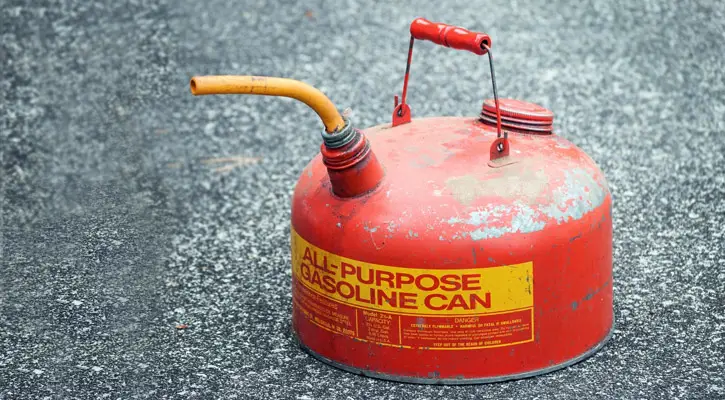Table of Contents
Are you a new chainsaw owner?
Or are you thinking about buying chainsaw but not sure how to properly fuel it?
Either way, if you want to learn how to mix chainsaw gas, then this post is for you.
I’ll guide you step-by-step on exactly how to do it.
The fact is, most chainsaws are built with 2-cycle (or 2-stroke) engines which require a mixture of fuel and oil to run.
Oil is mixed with gasoline (i.e. petrol) so that it can lubricate the internal parts of the engine while it operates. Without oil in the fuel tank, the internal components would seize up.
Chainsaw Buying Guides
Before I show you how to mix chainsaw fuel, I wanted to make you aware that I have several chainsaw buying guides to help you find the perfect tool for your needs.
If you’re shopping around for a chainsaw or want to upgrade your existing machine, these posts can help. Each one shows you what the top features are to look for in a particular type of chainsaw and offers reviews of the top products you can buy today.
So, take a look after you’re done reading this step-by-step post.
- The 10 Best Chainsaw Reviews
- The Best Lightweight Chainsaw Guide
- The Best Value Chainsaw Guide
- The Best Chainsaw for Home Use Guide
First Things First: Important Information on Gas, Oil, and Containers
Gas Type
The quality of the gasoline you put in your chainsaw is extremely important to the life of the engine.
Never use the cheap stuff. And never use petrol that contains ethanol.
At a minimum, use an octane rating of 89 for your ethanol-free petrol.
Fuel with a lower octane rating may increase the engine’s temperature which could cause damage to the internal parts.
Oil Type
2-cycle chainsaws require a special type of oil to be mixed with gasoline.
You can’t just mix regular motor oil that’s used in a car because it lacks several properties needed to lubricate a 2-cycle engine and will degrade the chainsaw’s performance.
Therefore, make sure the oil you buy says “two-cycle”, “2-cycle”, “2-stroke”, or “2T” on the container.
Approved Containers
When you’re mixing gasoline and oil for your chainsaw, it must be done in an approved container for storing fuel.
Milk jugs, anti-freeze jugs, glass containers, and other makeshift “gas cans” are not suitable for carrying or storing gasoline. Non-approved plastics become brittle with age and are incompatible with chemical properties of gasoline. Many of those containers are also not strong enough to withstand the pressures of expansion and contraction caused by temperature changes.
The best containers for handling gasoline are Underwriters Laboratories (UL) or Factory Mutual (FM) approved safety cans. So, make sure that the container you’re mixing your chainsaw gas in has either of these approvals stamped on it.
How to Mix Chainsaw Gas in 5 Easy Steps
Here are the steps for how to mix chainsaw gas.
Your chainsaw will likely take a 40 to 1 (40:1) or 50 to 1 (50:1) gas oil mixture. See your product manual to get the specifics. (You’ll find out more on how to mix these ratios later in this guide.)
Note: Never mix fuel in an enclosed space. Always perform these steps in a well-ventilated area.
Step 1
Gather your materials:
- UL or FM approved container
- 1 gallon or more of 89 octane or higher ethanol-free gasoline
- 3-ounce bottle or more of 2-cycle oil
- Chainsaw
Step 2
Open the approved container and pour in half of the gasoline.
Step 3
Pour in all of the oil necessary for your chainsaw’s 40:1 or 50:1 mixture. (Detailed charts on how to achieve these ratios are listed after the steps.)
Close the approved container and shake it for 10-15 seconds.
Step 4
Open the approved container and add in the rest of the gasoline.
Close the approved container and shake for another 10-15 seconds.
Step 5
Remove your chainsaw’s fuel tank cap and pour in the gas and oil mixture until it’s about 80% of the tank’s capacity.
Tighten the fuel tank cap and wipe up any spillage.
Gasoline to Oil Mixture Ratio Charts
Each chainsaw engine is manufactured differently and will require a specific ratio of gasoline to oil mixture to run.
The most common are 40 to 1 (or 4:1) and 50 to 1 (or 50:1) gas oil mixture.
The charts below will tell you how much of each type of fluid to use to achieve the correct gas to oil ratio for your chainsaw.
40 to 1 Gas Oil Mixture Chart
| Gallons of Gasoline | Fluid Ounces of Oil |
|---|---|
| 1 gal. | 3.2 oz. |
| 2 gal. | 6.4 oz. |
| 3 gal. | 9.6 oz. |
| 4 gal. | 12.8 oz. |
| 5 gal. | 16 oz. |
50 to 1 Gas Oil Mixture Chart
| Gallons of Gasoline | Fluid Ounces of Oil |
|---|---|
| 1 gal. | 2.6 oz. |
| 2 gal. | 5.12 oz. |
| 3 gal. | 7.68 oz. |
| 4 gal. | 10.24 oz. |
| 5 gal. | 12.8 oz. |
Additional Tips on Mixing Chainsaw Gas
- Never mix gas and oil in the tank of the chainsaw. Only use a UL or FM approved container.
- The correct ratio of petrol and 2-stroke oil for your chainsaw is very important. If you don’t mix it properly, your chainsaw will not run efficiently and could get damaged.
- Never refuel a chainsaw while it’s still running. Always turn the chainsaw off and wait until it’s cooled before refueling.
- Never start the chainsaw if there is fuel on your person, clothing, the chainsaw body, or the area around you.
- Never smoke while mixing, refueling, or using a chainsaw.
- Never mix more than one month’s supply of chainsaw fuel. Stale gas breaks down over time and forms gummy varnish deposits that can clog the carburetor during chainsaw operation. The best thing you can do is to only buy and mix enough gas and oil for the job at hand.
- Never store your chainsaw with leftover fluid in the fuel tank. Either run the chainsaw until the tank is empty or dump the gas and oil mixture into an approved container for storage.
What’s Next?
If you’re interested in learning more about the top chainsaws you can buy today, take a look at my other free guides.
Each one goes in-depth to help you find the perfect chainsaw for your needs.
- The 10 Best Chainsaws Available
- The Best Lightweight Chainsaw Guide
- The Best Value Chainsaw Guide
- The Best Chainsaw for Home Use Guide
I hope you enjoyed this post on how to mix chainsaw gas.
Happy sawing!

Your pal,
Chainsaw Larry

